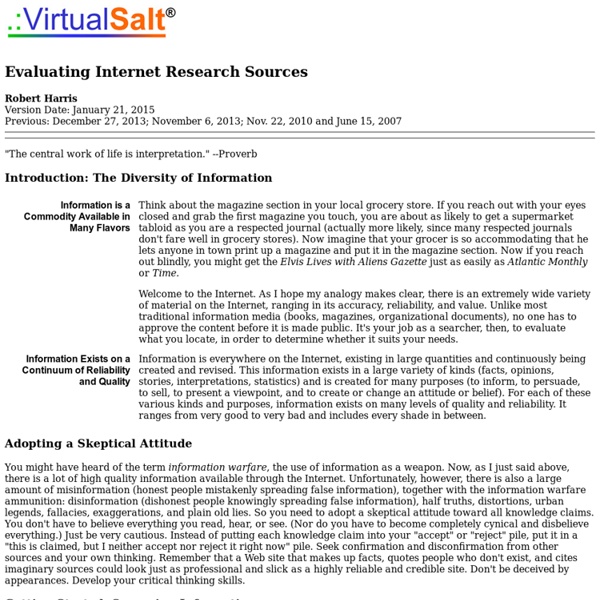



http://www.virtualsalt.com/evalu8it.htm
Evaluating Web Pages: Techniques to Apply & Questions to Ask 1. What can the URL tell you? Techniques for Web Evaluation : 1. How To Evaluate a Website - Basic Evaluation Checklist The Web has become the go-to source for many people doing all sorts of research these days. However, judging the truthfulness of information that you find online can be a bit problematic, especially if you’re looking for credible material you can cite in a research paper or academic project. Fiction and reality are not the same thing, but on the Web, it’s getting increasingly hard to tell the difference. To Cite or Not to Cite - That is the Question
Save The Pacific Northwest Tree Octopus Help Save The ENDANGERED From EXTINCTION! The Pacific Northwest Tree Octopus Rare photo of the elusive tree octopus The Pacific Northwest tree octopus (Octopus paxarbolis) can be found in the temperate rainforests of the Olympic Peninsula on the west coast of North America. Their habitat lies on the Eastern side of the Olympic mountain range, adjacent to Hood Canal.
The Sixteen Personality Types - High-Level ISTJ - The Duty Fulfiller Serious and quiet, interested in security and peaceful living. Extremely thorough, responsible, and dependable. Well-developed powers of concentration. Evaluate the quality and credibility of your sources Not all information is created equal. Just because you find information at the library does not guarantee that it is accurate or good research. In an academic setting, being able to critically evaluate information is necessary in order to conduct quality research. Each item you find must be evaluated to determine its quality and credibility in order to best support your research. City Brights: Howard Rheingold “Every man should have a built-in automatic crap detector operating inside him.” Ernest Hemingway, 1954 The answer to almost any question is available within seconds, courtesy of the invention that has altered how we discover knowledge – the search engine. Materializing answers from the air turns out to be the easy part – the part a machine can do.
4 Strategies for Reviewing Internet Search Results Students need strategies for reviewing Internet search results. My students consider themselves to be Internet experts. However, in my short time working with the class here is what I have discovered – they are not. Global HIV/AIDS at CDC - Global HIV/AIDS Global HIV/AIDSToday, an estimated 35.3 million people worldwide live with HIV/AIDS, with more than two-thirds living in Sub-Saharan Africa. Nearly three-fourths of the 2.3 million new HIV infections in 2012 occurred in these countries. CDC’s RoleCDC provides support to more than 70 countries (see countries where we work) to strengthen their national HIV/AIDS programs and build sustainable public health systems through the U.S. Crafter (role variant) Crafters are tactical operators, concrete in speech and utilitarian in action. In social situations, they are directive and reserved.[2] Crafters are masters at using tools of every type—artistic, technological, martial. Although they are introverts, they are authoritarian in their interactions with others and can be forceful at influencing people. They focus on accomplishing tasks efficiently and skillfully. To master the tool of their interest, Crafters require a certain degree of seclusion in which to practice.
Home - Evaluating resources - Library Guides at UC Berkeley To find out more about an author: Google the author's name or dig deeper in the library's biographical source databases. To find scholarly sources: When searching library article databases, look for a checkbox to narrow your results to Scholarly, Peer Reviewed or Peer Refereed publications. To evaluate a source's critical reception: Check in the library's book and film review databases to get a sense of how a source was received in the popular and scholarly press. To evaluate internet sources: The internet is a great place to find both scholarly and popular sources, but it's especially important to ask questions about authorship and publication when you're evaluating online resources. If it's unclear who exactly created or published certain works online, look for About pages on the site for more information, or search for exact quotations from the text in Google (using quotation marks) to see if you can find other places where the work has been published.
Project Information Literacy: Smart Talks Howard Rheingold: "Crap Detection 101: Required Coursework" Project Information Literacy, "Smart Talks," no. 5, January 3, 2011 Subscribe our Smart Talk RSS feed HIV/AIDS - HIV and AIDS Facts Considered to be a pandemic, HIV is mainly spread by sexual intercourse, however, can also be spread through blood transfusions, by sharing infected syringes, or even from infected mother to fetus. The advanced stage of the HIV infection is termed as AIDS. Thus, an HIV infection leads to AIDS.
Protector (role variant) The Protector Guardian is one of the 16 role variants of the Keirsey Temperament Sorter,[1] a self-assessed personality questionnaire designed to help people better understand themselves. David Keirsey originally described the Protector role variant; however, a brief summary of the personality types described by Isabel Myers contributed to its development. Protectors correlate with the ISFJ Myers-Briggs type.[2] Protectors are observant, cooperative, informative, and attentive. Evaluating Internet Sources : Olson Library Because of the hodge-podge of information on the Internet, it is very important you develop evaluation skills to assist you in identifying quality Web pages. There are six (6) criteria that should be applied when evaluating any Web site: authority, accuracy, objectivity, currency, coverage, and appearance. For each criteria, there are several questions to be asked. The more questions you can answer "yes", the more likely the Web site is one of quality. Below is a chart listing key questions for each of the six criteria.